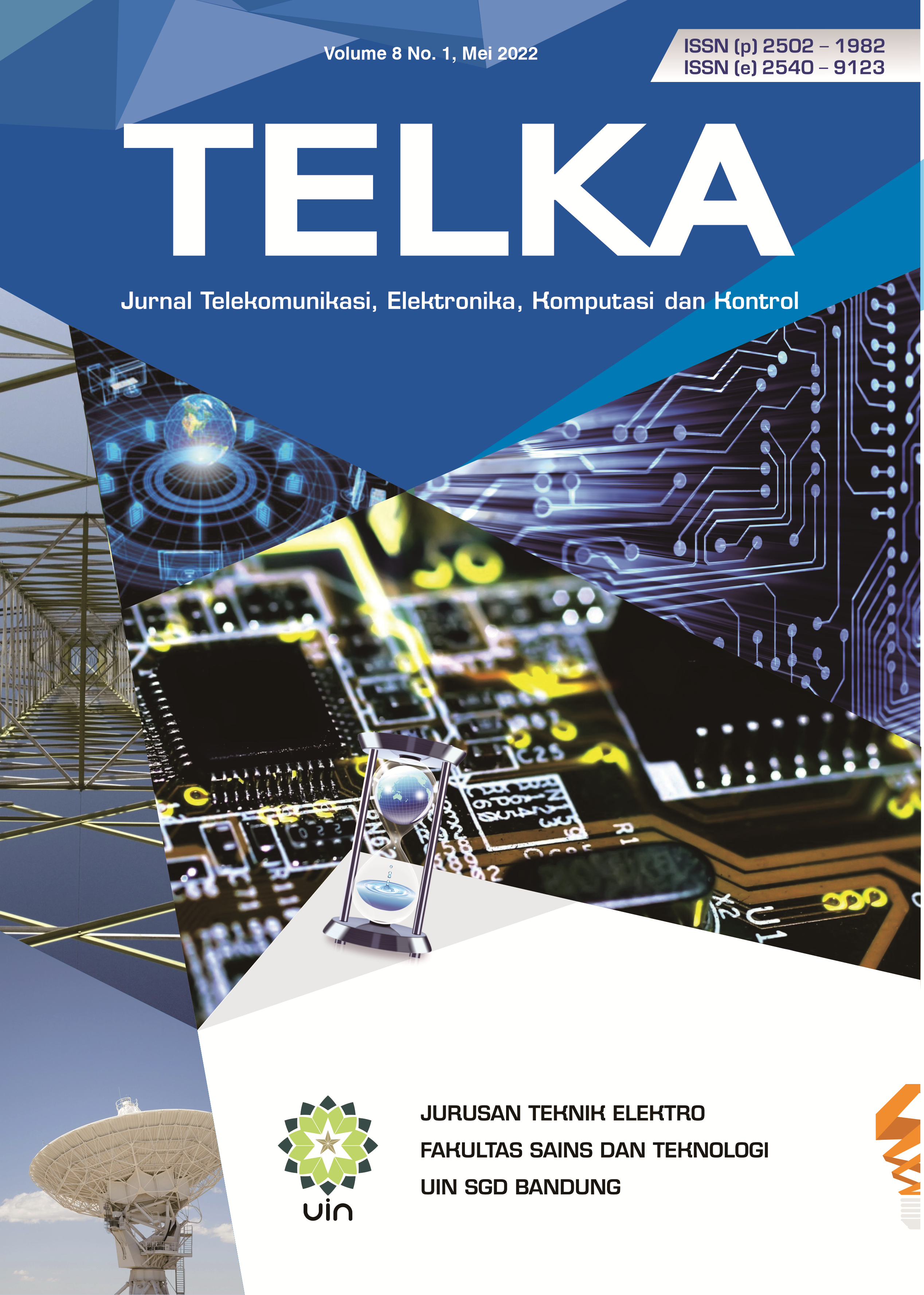Sistem Keamanan Pintu Rumah Berbasis Internet of Things via Pesan Telegram
DOI:
https://doi.org/10.15575/telka.v8n1.49-59Kata Kunci:
Sistem keamanan pintu, IoT, Wemos D1, Proximity, TelegramAbstrak
Pada era sekarang ini, banyak didapati kasus keamanan rumah yang semakin kompleks. Hal ini yang mendasari penelitian ini dilakukan. Penelitian ini bertujuan membuat sistem keamanan pintu rumah dengan notifikasi pesan via aplikasi telegram yang diharapkan memberikan rasa aman bagi pemilik rumah dengan. Sistem keamanan pintu rumah ini menggunakan Wemos D1 R1 sebagai mikrokontroler. Sistem ini dirancang dengan menggunakan aplikasi telegram messenger sebagai notifikasi. Penelitian ini menggunakan proximity sensor yang berfungsi mendeteksi setiap gerakan di sekitar pintu. Di atas pintu dipasang kamera yang dapat menangkap gambar atau objek saat ada gerakan. Sistem ini memiliki 2 cara kerja, yaitu pengecekan secara otomatis dan manual. Sistem bekerja secara otomatis pada saat sensor menangkap gerakan dan kamera langsung menggambil gambar, selanjutnya mengirimkan gambar tersebut ke aplikasi telegram. Sedanhgkan sistem bekerja secara manual dengan cara memasukkan perintah lewat BOT telegram untuk membuka pintu rumah. Hasil pengujian nilai rata- rata kinerja alat secara otomatis dari penangkapan gambar atau objek sebesar 16,7 detik, nilai rata-rata waktu kinerja alat secara manual sebesar 9,7 detik. Nilai rata-rata waktu kinerja solenoid doorlock sebesar 7,6 detik. Hasil pengujian kualitas layanan menunjukkan rata-rata delay sebesar 3,244 detik, dan rata-rata throughput sebesar 301.465 byte/s.
In today's era, many cases of home security are increasingly complex. This is what underlies this research. This study aims to create a home door security system with message notifications via the telegram application which is expected to provide a sense of security for homeowners. This home door security system uses Wemos D1 R1 as a microcontroller. This system is designed using the telegram messenger application as a notification. This study uses a proximity sensor to detect any movement around the door. Above the door is installed a camera that can capture images or objects when there is movement. This system has 2 ways of working, namely checking automatically and manually. The system works automatically when the sensor captures motion and the camera immediately takes a picture, then sends the image to the telegram application. While the system works manually by entering commands via the telegram BOT to open the door of the house. The results of testing the average value of the tool's performance automatically from capturing images or objects of 16.7 seconds, the average value of manual tool performance takes 9.7 seconds. The average value of the door locked solenoid performance takes 7.6 seconds. The result of testing the quality of data services show an average delay of 3,244 seconds, and an average throughput is 301,465 byte/s.
Referensi
Arafat, “Sistem Pengamanan Pintu Rumah Berbasis Internet of Things dengan ESP8266,” Technologia, vol. 7, no. 3, pp. 262-267, 2013.
R. Khana and U. Usnul, “Rancang Bangun Sistem Keamanan Rumah Berbasis Internet of Things Dengan Platform Android,” Jurnal Kajian Teknik Elektro, vol. 3, no. 1, pp. 18–31, 2018.
M. I. Kurniawan, U. Sunarya, and R. Tulloh, “Internet of Things : Sistem Keamanan Rumah berbasis Raspberry Pi dan Telegram Messenger,” ELKOMIKA Jurnal Teknik Energi Elektrik, Teknik Telekomunikasi & Teknik Elektronika, vol. 6, no. 1, p. 1, 2018.
D. Nataliana, S. Anwari, and M. S. Akbar, “Implementasi Prototype Sistem Home security dengan Pemanfaatan Kode Akses berbasis Arduino Mega,” ELKOMIKA Jurnal Teknik Energi Elektrik, Teknik Telekomunikasi & Teknik Elektronika, vol. 5, no. 2, p. 119, 2018.
Z. Abidin, S.I. Lesatariningati, “Sistem keamanan dan monitoring rumah pintar secara online menggunakan perangkat mobile,” Jurnal Teknik Komputer, vol. 3, no. 2, pp. 13–17, 2014.
I. Alfannizar and Y. Rahayu, “Perancangan Dan Pembuatan Alat Home Electricity Based Home Appliance Controller Berbasis Internet of Things,” Jom FTEKNIK, vol. 5, no. 1, pp. 1–6, 2018.
S. Siswanto, T. Nurhadiyan, and M. Junaedi, “Prototype Smart Home Dengan Konsep Iot (Internet of Thing) Berbasis Nodemcu Dan Telegram,” Jurnal Sistem Informasi dan Informatika, vol. 3, no. 1, pp. 85–93, 2020.
Eeeboxbd.com, “WeMos D1 R1 WiFi Development Board.” [Online]. Available: https://eeeboxbd.com/product/wemos-d1-r1-wifi-development-board/.
E. Systems, “ESP8266EX Datasheet,” in Espressif Systems, 2020, p. 31.
H. Sullinger, Getting Started With The Arduino: Arduino Integrated Development Environment: Install The Arduino Software (Ide) On Windows Pcs. Independently Published, 2021.
J. Oxer and H. Blemings, Practical Arduino: Cool Projects for Open Source Hardware. Apress, 2011.
S. Baco, L. Belakang, and R. Masalah, “Pengembangan Sistem Pengaman Rumah dengan Security Password Menggunakan Sensor Gerak berbasis Mikrokontroller ATmega8,” Seminar Nasional Inovasi dan Aplikasi Teknolgi Di Industri, pp. 1–7, 2017.
Tinkbox, “Proximity Sensor/Switch E18-D80NK,” 2014, pp. 1–5.
A. Industries, “Overview TTL Serial Camera.” [Online]. Available: https://learn.adafruit.com/ttl-serial-camera. [Accessed: 30-Sep-2021].
E. A. Core, “ESP8266 Arduino,” GitHub. [Online]. Available: https://arduino-esp8266.readthedocs.io/en/latest/. [Accessed: 29-Sep-2021].
M. C. Adapter and M. Sd, “Micro SD Card Module for Arduino,” 2014, pp. 1–21.
Telegram.org, “Telegram Applications.” [Online]. Available: https://telegram.org/apps.













